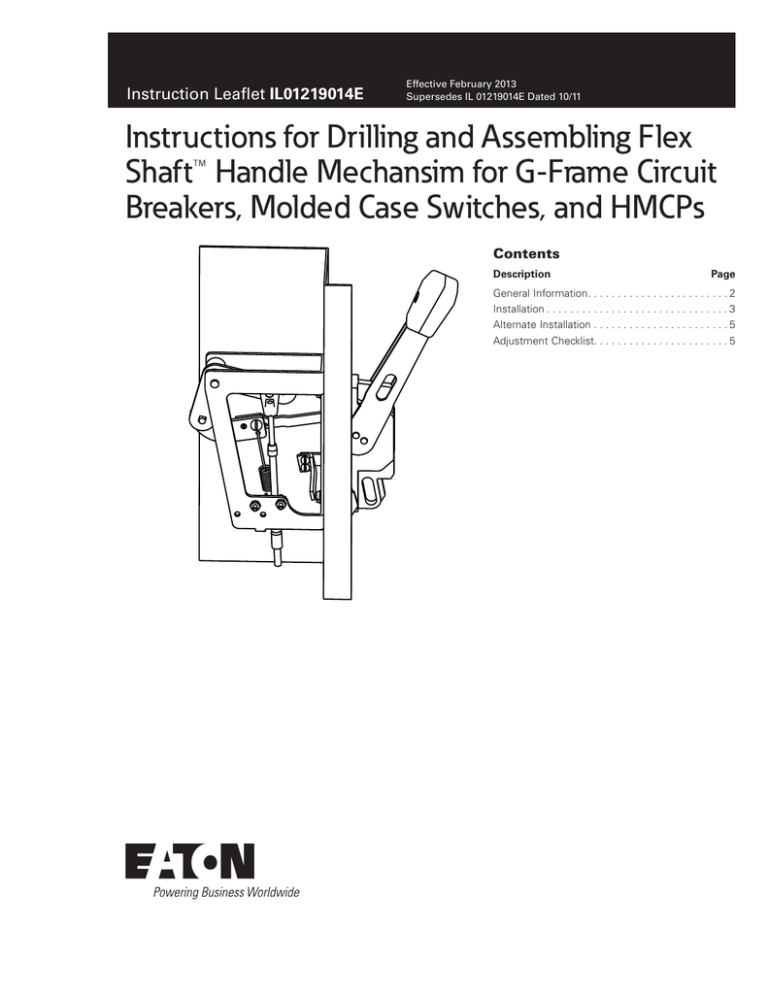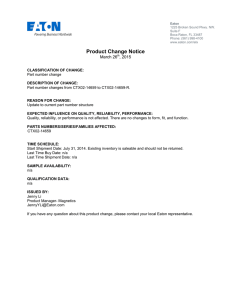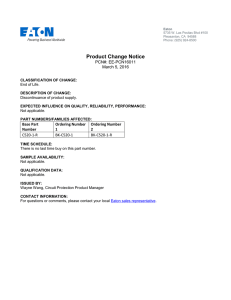
Instruction Leaflet IL01219014E
Effective February 2013
Supersedes IL 01219014E Dated 10/11
Instructions for Drilling and Assembling Flex
Shaft™ Handle Mechansim for G-Frame Circuit
Breakers, Molded Case Switches, and HMCPs
Contents
Description
Page
General Information. . . . . . . . . . . . . . . . . . . . . . . . 2
Installation. . . . . . . . . . . . . . . . . . . . . . . . . . . . . . . 3
Alternate Installation. . . . . . . . . . . . . . . . . . . . . . . 5
Adjustment Checklist. . . . . . . . . . . . . . . . . . . . . . . 5
Instructions for Drilling and Assembling Flex
Shaft™ Handle Mechansim for G-Frame Circuit
Breakers, Molded Case Switches, and HMCPs
Instruction Leaflet IL01219014E
Effective February 2013
DO NOT ATTEMPT TO INSTALL OR PERFORM
MAINTENANCE ON EQUIPMENT WHILE IT IS
ENERGIZED. DEATH, SEVERE PERSONAL INJURY OR SUBSTANTIAL PROPERTY DAMAGE
CAN RESULT FROM CONTACT WITH ENERGIZED EQUIPMENT. ALWAYS VERIFY THAT NO
VOLTAGE IS PRESENT BEFORE PROCEEDING
WITH THE TASK, AND ALWAYS FOLLOW GENERALLY ACCEPTED SAFETY PROCEDURES.
EATON IS NOT LIABLE FOR THE MISAPPLICATION OR MISINSTALLATION OF ITS PRODUCTS.
The user is cautioned to observe all recommendations,
warnings, and cautions relating to the safety of personnel
and equipment as well as all general and local health and
safety laws, codes, and procedures.
The recommendations and information contained herein
are based on Eaton’s experience and judgment, but should
not be considered to be all-inclusive or covering every
application or circumstance which may arise. If any
questions arise, contact Eaton for further information
or instructions.
GENERAL INFORMATION
The Flex Shaft handle mechanism provides a means of
externally operating the circuit breaker and can be
applied to enclosures of varying heights and depths. The
handle can be used with NEMA 1, 3R, 3R,12, 4, and 4X enclosure
applications, depending on the accessory components
selected. An operating handle, flexible shaft, and mechanism are required for standard application. Four lengths
of shafts are available for use with the wide range of depths
of various enclosures (3' through 6'). When
selecting the length of the Flexible Shaft, ensure Minimum Bending Radius of 4 inches is maintained to
operate properly. The standard method of shipment includes the
mechanism preset at the factory. If minor field adjustments are required,
see Fig. 1-3. For this publication, the term circuit breaker shall also
include the molded case switch.
WHEN INSTALLING A NEW HANDLE MECHANISM, OR A
NEW CIRCUIT BREAKER AND HANDLE MECHANISM IN AN
EXISTING ELECTRICAL SYSTEM, MAKE SURE THERE IS NO
VOLTAGE PRESENT WHERE WORK IS TO BE PERFORMED.
SPECIAL ATTENTION SHOULD BE PAID TO REVERSE FEED
APPLICATIONS TO ENSURE NO VOLTAGE IS PRESENT. THE
VOLTAGE IN ENERGIZED, EQUIPMENT CAN CAUSE DEATH
OR SEVERE PERSONAL INJURY.
TOGGLE
MECHANISM
ASSEMBLY
ACTUATOR
MECHANISM
OUTER
HANDLE
MECHANISM
Fig. A Hardware Contents.
2
EATON CORPORATION www.eaton.com
Fig. B Assembly Contents.
Instructions for Drilling and Assembling Flex
Shaft™ Handle Mechansim for G-Frame Circuit
Breakers, Molded Case Switches, and HMCPs
Instruction Leaflet IL01219014E
Effective February 2013
1/4 LOCK WASHERS
(2 PLACES)
BELL CRANK
TOGGLE MECHANISM
ASSEMBLY
ENCLOSURE
OUTER
HANDLE
MECHANISM
OUTER HANDLE
MECH. MOUNTING
SCREWS,
1/4-20 x .875 HEX
(2 PLACES)
THESE ITEMS ARE TO BE
ASSEMBLED AFTER HANDLE
IS MOUNTED TO ENCLOSURE
Fig. 1-1 Securing Actuator Mechanism to Breaker and Toggle Mechanism and Handle to Enclosure.
INSTALLATION
For assembly steps, refer to Fig 1-1, unless otherwise noted.
1. Mount breaker with two, 6-32 x 3.00 breaker mounting
screws. Install screws in the diagonal fashion as shown.
2. Place the outer handle mechanism with attached gasket over
the enclosure cutout. (For cut-out dimensions, refer to Fig. 1-7.)
Insert the top ¼-20 outer handle mech mounting screw and
lockwasher through the enclosure and thread into the outer
handle mechanism for a few turns, but not all the way.
3. Slide the toggle mechanism assembly over the top of the
handle mounting screw. Insert the bottom outer handle mechanism mounting screw and lockwasher through the toggle mechanism bracket, through the enclosure, into the handle. Fully
tighten both mounting screws.
4. Insert the adapter link into the pin of the bell crank via the
largest hole on the link (see Fig. 1-4). Secure the adapter link
by inserting the E-ring into the slot on the bell crank pin.
5. Rotate the bell crank towards the handle and rotate the
handle to the ON position. Align the adapter link and attach
it to the actuator link using the 1/4-20 pan head screw and
nut (see Fig. 1-5).
6. Connect the long end of the spring through the hole in
the adapter link. Hook the shorter end of the spring into
the tab on the lower portion of the toggle mechanism
(see Fig. 1-6).
7. Mount door interlock hasp to handle using two #8-32
SEMS screws (see Fig. 1-2). Hasp orientation may be
modified per customer requirements and enclosures.
8. Remove and discard the two secondary cover screws
shown in Fig. 1-1. Verify that breaker is in the trip position.
Put outer handle mechanism in the trip position for ease of
mounting actuator mechanism.
9. Place actuator mechanism around the front of the breaker
(see Fig. 1-1). Orient handle pivot bracket so that the slot
captures the breaker handle. Fasten securely with the two
6-32 x 3.50 actuator mech/breaker mounting screws and
lockwashers, as shown.
10. Operate handle mechanism to ensure functionality.
To operate, either close door or defeat door interlock
lever.
11. If minor adjustments are necessary, refer to adjustment checklist on page 5.
12. Install appropriate door hardware (supplied) (see Fig. 1-7).
EATON CORPORATION www.eaton.com
3
Instructions for Drilling and Assembling Flex
Shaft™ Handle Mechansim for G-Frame Circuit
Breakers, Molded Case Switches, and HMCPs
Instruction Leaflet IL01219014E
Effective February 2013
NUT / LOCK WASHER,
1/4-20
ADAPTER LINK
CONNECTS WITH
BELL CRANK.
ROTATE HANDLE TO
ON POSITION
HANDLE
MECHANISM
1/4-20 x .620
SCREW
SPRING
ASSEMBLE ADAPTER
LINK TO BELL CRANK.
SECURE USING E-RING
INTERLOCK HASP/HOOK
SCREWS, 8-32 x .375
DOOR INTERLOCK HASP.
(4 PLACES)
ORIENTATION MAY BE
MODIFIED DEPENDING ON
CUSTOMER REQUIREMENTS
AND ENCLOSURES.
Fig. 1-4 Assembly of Adapter Link to Bell Crank.
Fig. 1-2 Outer Handle Mechanism Assembly.
ROTATE BELL CRANK
AND ADAPTER LINK
TO LINE UP HOLES.
ASSEMBLE ADAPTER
LINK WITH SCREW,
WASHER, AND NUT.
Fig. 1-5 Assembly of Adapter Link to Actuator Link.
Fig. 1-3 E-Frame Actuator Mechanism.
ATTACH SHORT END
OF SPRING THROUGH
HOLE IN TAB OF
TOGGLE MECHANISM.
PLACE LONG END
OF SPRING THROUGH
HOLE IN ADAPTER LINK.
Fig. 1-6 Assembly of Spring to Toggle Mechanism.
4
EATON CORPORATION www.eaton.com
Instructions for Drilling and Assembling Flex
Shaft™ Handle Mechansim for G-Frame Circuit
Breakers, Molded Case Switches, and HMCPs
BEFORE ANY INSTALLATION OR MAINTENANCE IS PERFORMED, MAKE SURE THAT THE
BREAKER IS NOR ENERGIZED.
ALTERNATE INSTALLATION
In the event a customer must disassemble the
preassembled Flex Shaft handle mechanism, the procedure listed below must be followed before continuing with the
"Installation" instructions. (See Fig. 1-3).
A. Remove the flat washer, lockwasher, and nut
assembly.
B. Loosen bulkhead connectors and remove Flex Shaft
from actuator mechanism. Shaft may not be routed
as required.
C. Place circuit breaker in the ON position.
D. Place the operating handle in the full ON position.
E. Replace Flex Shaft through the actuator mechanism.
Center the bulkhead connectors on the threaded
portion and tighten to approximately 70 in-lb.
F. Place slot in handle pivot bracket over the breaker
handle while still in the ON position. Turn the
lifting washer/nut until flush against the slider plate.
G. Replace the flat washer, lockwasher, and nut assembly for the Flexible Shaft assembly. Tighten both
nuts to approximately 45 in-lb.
H. Check operation of mechanism for ON, OFF, and
reset. Check the reset position of the actuator
mechanism, that the lifting nut and sleeve of shaft do
not come in contact with each other (see Fig. 1-3).
If they do, move bulkhead connectors accordingly.
If mechanism functions incorrectly, repeat
procedure or go to Adjustment Checklist.
Instruction Leaflet IL01219014E
Effective February 2013
Note: Check the reset position of the actuator
mechanism, that the lifting nut and sleeve of shaft
do not come into contact with each other (Fig. 1-3)
If they do, move bulkhead connectors
accordingly.
Situation:
Breaker Resets after tripping, but does not turn ON.
Adjustment:
Loosen the washer/lockwasher/nut on the end of the shaft while tightening the
lifting washer/nut until breaker turns on with positive action. Tighten both nuts
and recheck for ON, OFF, and Reset positions (Fig. 1-3 ).
Note: Be certain after adjustment to have a minimum
of 1 thread past the washer/lockwasher/nut assembly
(Fig. 1-3).
If any other adjustment problems should arise, contact
your local Eaton representative.
ADJUSTMENT CHECKLIST
Situation:
Breaker turns ON and OFF, but will not Reset when
tripped.
Adjustment:
Loosen the lifting washer/nut while tightening the washer/
llockwasher/nut, two or three turns should be sufficient (see Fig.
1-3 ).
Fig. 1-7 Flange Drilling Plan for Handle and Interlock Blade
Mounting Dimensions.
EATON CORPORATION www.eaton.com
5
Instruction Leaflet IL01219014E
Effective February 2013
Notes:
6
EATON CORPORATION www.eaton.com
Instructions for Drilling and Assembling Flex
Shaft™ Handle Mechansim for G-Frame Circuit
Breakers, Molded Case Switches, and HMCPs
Instructions for Drilling and Assembling Flex
Shaft™ Handle Mechansim for G-Frame Circuit
Breakers, Molded Case Switches, and HMCPs
Instruction Leaflet IL01219014E
Effective February 2013
Notes:
EATON CORPORATION www.eaton.com
7
Instruction Leaflet IL01219014E
Effective February 2013
Instructions for Drilling and Assembling Flex
Shaft™ Handle Mechansim for G-Frame Circuit
Breakers, Molded Case Switches, and HMCPs
The instructions for installation, testing, maintenance, or repair
herein are provided for the use of the product in general commercial
applications and may not be appropriate for use in nuclear applications. Additional instructions may be available upon specific request
to replace, amend, or supplement these instructions to qualify them
for use with the product in safety-related applications in a nuclear
facility.
This Instruction Booklet is published solely for information purposes
and should not be considered all-inclusive. If further information is
required, you should consult an authorized Eaton sales representative.
The sale of the product shown in this literature is subject to the
terms and conditions outlined in appropriate Eaton selling policies
or other contractual agreement between the parties. This literature
is not intended to and does not enlarge or add to any such contract.
The sole source governing the rights and remedies of any purchaser
of this equipment is the contract between the purchaser and Eaton.
NO WARRANTIES, EXPRESSED OR IMPLIED, INCLUDING
WARRANTIES OF FITNESS FOR A PARTICULAR PURPOSE OR
MERCHANTABILITY, OR WARRANTIES ARISING FROM COURSE
OF DEALING OR USAGE OF TRADE, ARE MADE REGARDING
THE INFORMATION, RECOMMENDATIONS, AND DESCRIPTIONS
CONTAINED HEREIN.
In no event will Eaton be responsible to the purchaser or user in
contract, in tort (including negligence), strict liability or otherwise
for any special, indirect, incidental or consequential damage or loss
whatsoever, including but not limited to damage or loss of use of
equipment, plant or power system, cost of capital, loss of power,
additional expenses in the use of existing power facilities, or claims
against the purchaser or user by its customers resulting from the
use of the information, recommendations and description contained
herein.
Eaton Corporation
Electrical Sector
1111 Superior Ave.
Cleveland, OH 44114
United States
877-ETN-CARE (877-386-2273)
Eaton.com
© 2013 Eaton Corporation
All Rights Reserved
Printed in USA
Publication No. IL01219014E / TBG001061
Part No. IL01219014EH02
February 2013
Eaton is a registered trademark of Eaton
Corporation.
All other trademarks are property of their
respective owners.



